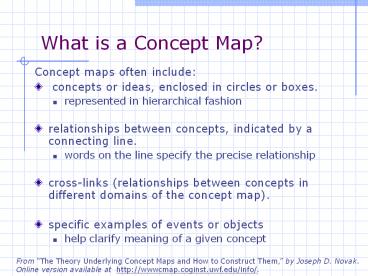What is a Concept Map? PowerPoint PPT Presentation
1 / 12
Title: What is a Concept Map?
1
What is a Concept Map?
- Concept maps often include
- concepts or ideas, enclosed in circles or boxes.
- represented in hierarchical fashion
- relationships between concepts, indicated by a
connecting line. - words on the line specify the precise
relationship - cross-links (relationships between concepts in
different domains of the concept map). - specific examples of events or objects
- help clarify meaning of a given concept
From The Theory Underlying Concept Maps and How
to Construct Them, by Joseph D. Novak. Online
version available at http//wwwcmap.coginst.uwf.e
du/info/.
2
Concept Map Sample
Novak, J.D. Gowin, D.B. (1984). Learning How to
Learn. New York Cambridge University Press.
3
Concept Map Sample
From http//www.inspiration.com/diagrams/ed/concep
tmap2.html. Map by Paul Rutherford.
4
Not a Concept Map Sample
Life-Cycle Analysis Flow Chart
5
Uses of Concept Mapping
- BRAINSTORMING SUPPORT Provides format and
direction for planning and generating new ideas. - STUDY AID Facilitates effective note taking,
summarizes newly learned concepts, or lends some
structure or activity to reflective thinking. - INSTRUCTIONAL TOOL Serves as visual aid or
schematic summary, demonstrates complex
relationships, or provides a means for assessment
of understanding or isolation of misconceptions.
6
Focus Pre- and post-lesson assessments
- Help students and educators recognize what
students already know. - Focus students on subject at hand, and help them
frame their own learning. - Allow educators to catch misconceptions early.
7
Learning as Conceptual Change
- Students have pre-existing ideas, mental models,
vocabulary, etc. (correct or incorrect). - Student must understand relationships between
existing ideas and concepts and newly-presented
meanings for internalization to occur. - Second language acquisition example.
8
Examples from Science Technology for the
Environment
- Students were asked to
- draw concept maps of key ideas in assigned
readings. - draw simple concept maps, then elaborate and
refine based on new information. - Atmospheric System Example
- draw two concept maps comparing and contrasting
environmental issues. - Tropospheric Ozone vs. Stratospheric Ozone
Depletion - Global Climate Change vs. Ozone Depletion
- examine complexities of environmental problems
using concept maps. - Causes of extinction of a frog species
9
Application
- Green Building Discussion -- What is a Green
Building? - What are the benefits of this sort of exercise
for students? For teachers? - What are some possible shortcomings or
limitations of concept maps?
10
Discussion
- Questions? Comments? Concerns?
11
Links to Concept Mapping Websites
- General / How To
- http//classes.aces.uiuc.edu/ACES100/Mind/CMap.htm
l - Offers general background information, as
well as useful discussion of different types of
concept maps. - http//www.ed.gov/databases/ERIC_Digests/ed407938.
html - General information. - http//www.coun.uvic.ca/learn/program/hndouts/map_
ho.html - General information. - http//www.inov8.engr.psu.edu/faculty/cmap.htm -
General information, useful discussion of how to
create concept maps. - http//www.mindtools.com/mindmaps.html -
"Improving Note Taking with Concept Maps." - Software
- http//www.inspiration.com - Most commonly used
concept-mapping software. Site also contains
information about theory, and instruction on
mapping methods (see, for example,
http//www.inspiration.com/inspclass.html). - http//www.mindmapper.com - Alternate
concept-mapping software. - Theory
- http//wwwcmap.coginst.uwf.edu/info/ - "The
Theory Underlying Concept Maps and How To
Construct Them," by J. D. Novak. - Examples / Uses
- http//www.sar.usf.edu/edorsz/ - Programmable
concept map that demonstrates their potential
complexity and possible application. - http//www.schoolnet.edu.mo/general/biology/temp/c
map/respir.html - Map of cellular respiration. - http//ksi.cpsc.ucalgary.ca/articles/ConceptMaps/C
M.htmlSection1 - Discusses practical application
of concept map as a hypertext tool.
12
Additional Resources
- Ausubel, D. P. (1963). The Psychology of
Meaningful Verbal Learning. New York Grune and
Stratton. - Ausubel, D. P. (1968). Educational Psychology A
Cognitive View. New York Holt, Rinehart and
Winston. - Bloom, B. S. (1956). Taxonomy of Educational
Objectives--The Classification of Educational
Goals. New York David McKay. - Hyerle, D. (1996). Visual Tools for Constructing
Knowledge. Alexandria, Virginia Association for
Supervision and Curriculum Development. - Novak, J.D. Gowin, D.B. (1984). Learning How to
Learn. New York Cambridge University Press.

